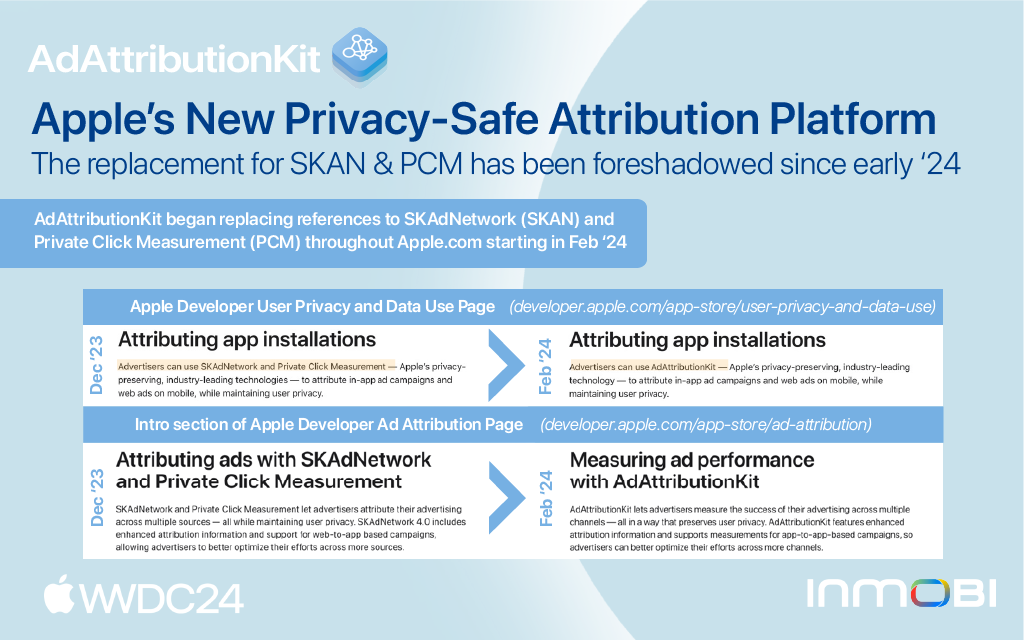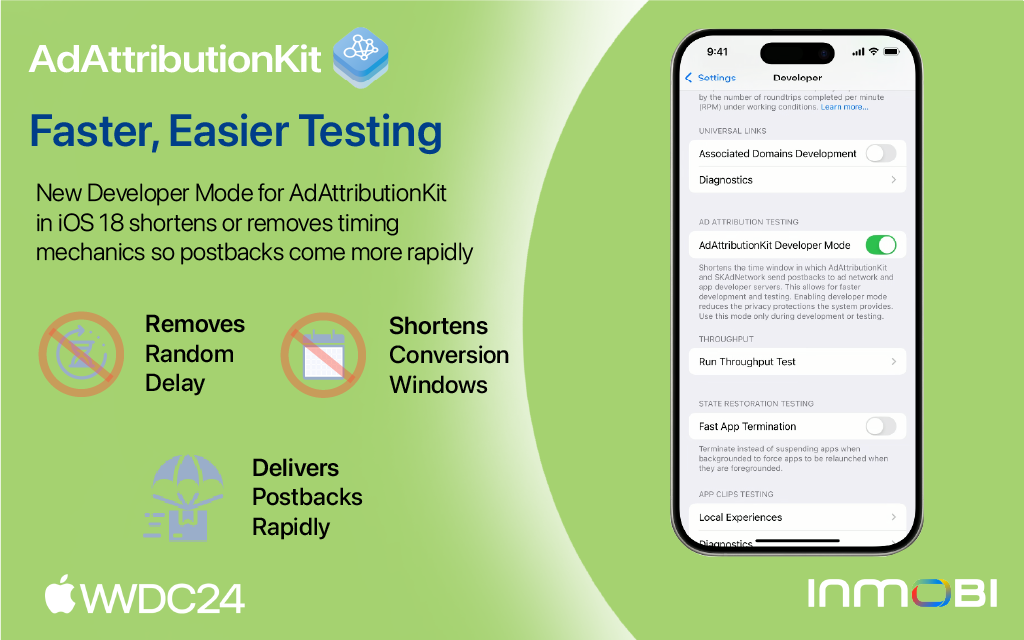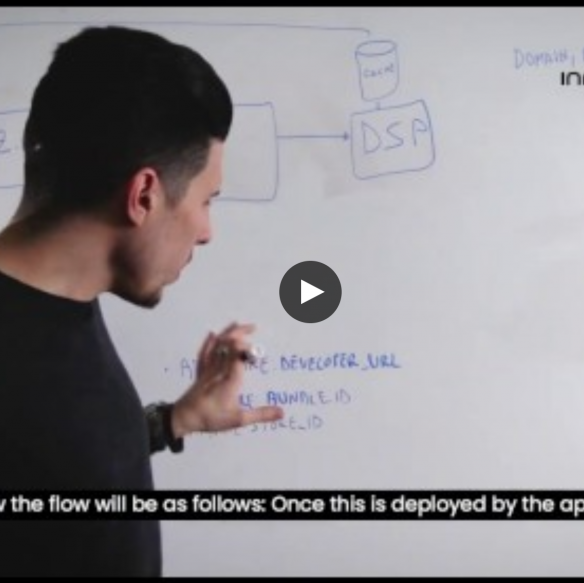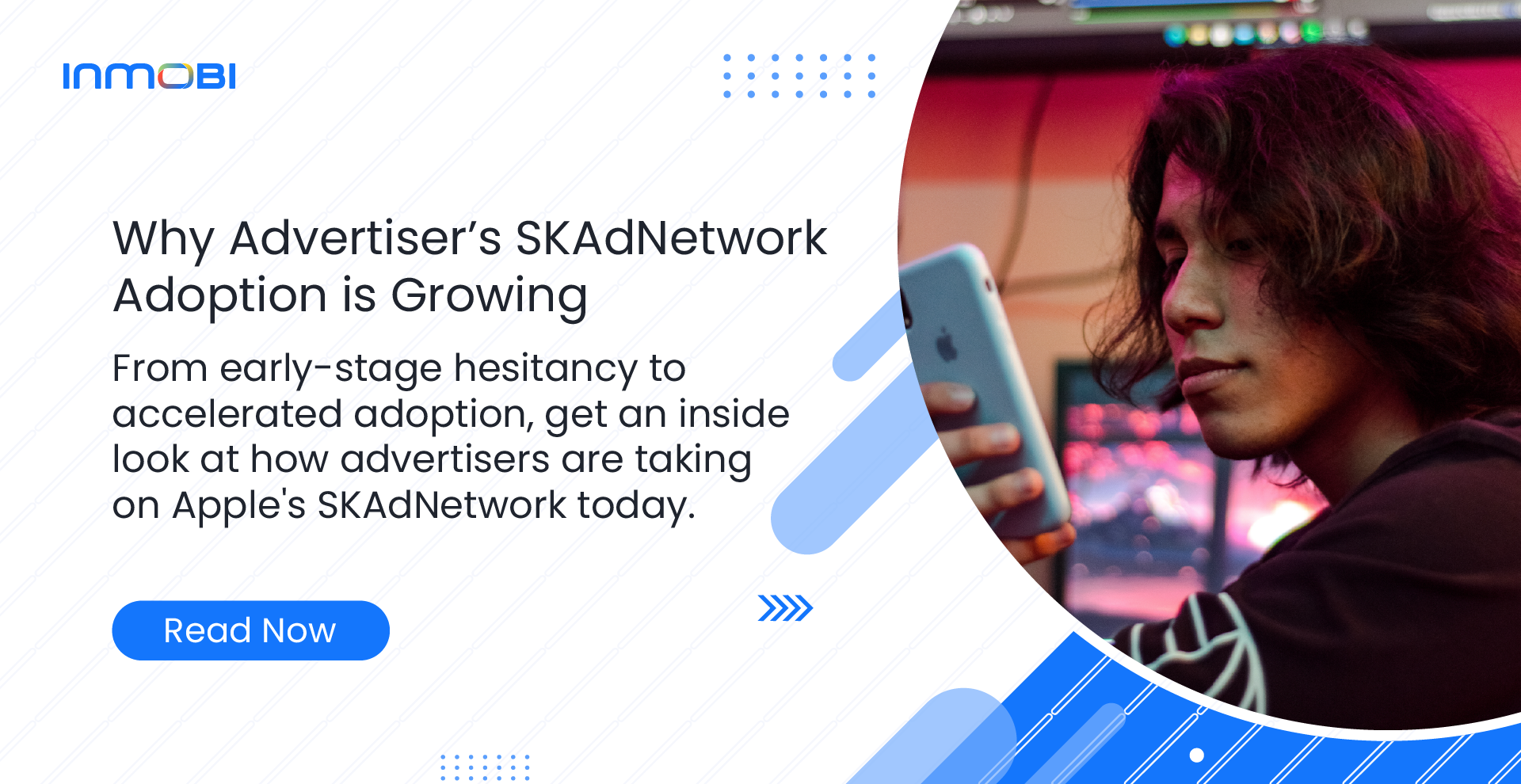Sara Camden
- Acquiring New Users
- Advertising
Apple's new and improved framework for privacy-preserving campaign attribution on iOS

During Apple’s 2024 Worldwide Developer Conference (WWDC), we got to meet their reimagined privacy-preserving attribution framework, AdAttributionKit (AAK) which is summarized nicely in this video. This new tool is the most encouraging sign yet that Apple is committed to supporting a healthy ad ecosystem with a workable solution for privacy-safe campaign attribution, and comes with some new features worth celebrating.
InMobi's iOS product leader Pranay Pant and I took advantage of a WWDC Lab consultation with the team behind AdAttributionKit, which provided helpful clarity about Apple’s latest vision for attributing campaign performance while protecting user privacy. Let’s dig into all the key details to know about AdAttributionKit, where SKAdNetwork fits into the new measurement equation on iOS, and what it all means for app marketers.
Background
Apple has been previewing the arrival of AdAttributionKit since the start of 2024, with early takes interpreting it as a new tool that would run parallel to SKAdNetwork (SKAN) for the purposes of supporting alternative iOS app marketplace campaign attribution to fulfil requirements of the European Digital Markets Act (DMA). While AAK does indeed support campaign attribution for alternative marketplaces, Apple actually began quietly replacing references to the 5th version of SKAN that was announced during WWDC 2023 but never materialized, with AAK throughout apple.com. The same pattern also emerged where AdAttributionKit began appearing throughout their site in place of Private Click Measurement (PCM), SKAN’s web measurement companion. You can see a few examples I caught in the image below.

Fast-forward to today, and now Apple has confirmed that going forward, privacy-preserving attribution for both app and web based conversions will live under the unified heading of AdAttributionKit. The initial iteration of App AdAttributionKit came packaged with iOS 17.4 with the exception of what’s likely its most exciting feature, re-engagement, which will be supported starting in iOS 18.
What About SKAN?
Apple did confirm that SKAN will only exist in a maintenance mode going forward and eventually be sunset, but app marketers and their partners can rest assured efforts invested incorporating SKAN into their iOS growth strategies have not been in vain. AdAttributionKit builds on the familiar functionality of SKAN 4.0, and the two systems will remain interoperable.
What’s New With AdAttributionKit?
Insight Into Re-Engagement Conversions on iOS
The app marketing ecosystem can collectively rejoice because AdAttributionKit comes with support for measuring conversion actions users who have already installed an advertised app take as a result of their in-app ad campaigns. This welcomed new functionality addresses one of the most frequently cited pain points of working with its predecessor SKAN.

How Re-Engagement in AdAttributionKit Works
If an advertiser wants a campaign to measure re-engagement conversions, their ad network partners simply need to include the new “Eligible for Reengagement” property in their impression payload with a value of “true”. Now, when users who have already installed the advertiser’s app click on an ad and complete a desired action, these conversions will be identified in postbacks via a new parameter called “Conversion Type” with a value of “Reengagement”.
Here’s some important details to note about AdAttributionKit’s re-engagement functionality:
- Only a single winning ad receives credit for driving re-engagement. Non-winning ad networks are ineligible.
- Ads that drive re-engagement are eligible to receive up to 3 postbacks following the same conversion windows defined in SKAN 4.0.
- Hierarchical Conversion Value mapping schemas are currently defined at the app level, and should account for both install and re-engagement conversion events in a single schema.
- For re-engagement, only click-based conversions are supported.
- Ad Networks can provide separate URLs to be presented with ad impressions for when a user re-engages VS. installs an app.
- Universal links that open a destination within the advertised app are supported in re-engagement, and will be appended with a query parameter that identifies when a re-engagement is attributed to their advertising efforts.
- Re-engagement in AAK is compatible with SKOverlay and SKStoreProductViewController StoreKit ad renders as well as all custom ad formats
More Meaningful Consideration for How Users Interact with In-App Ads When Assigning Attribution Credit
Like app install campaigns in SKAN 2.2 and above, AdAttributionKit can award credit for influencing a conversion event to one winning ad and up to five additional non-winning ads as long as each ad was in view for at least 2 seconds. What changes in AAK is how winning and non-winning ads eligible for attribution credit get calculated.
In addition to how recently an ad was presented to a user who converts, AdAttributionKit now considers a new parameter called ‘Interaction Type’ that distinguishes between ‘Clicks’ and ‘Views’ when assigning attribution credit. This new ‘Interaction Type’ parameter replaces and improves upon the ‘Fidelity Type’ value from SKAN, which was not a fully accurate representation of whether an ad had been truly clicked or just viewed. Interaction Type removes any ambiguity around clicks and views for all supported ad formats so that only a user’s real-world engagement with an ad is considered when assigning attribution credit.

The Apple team clarified during my WWDC Lab consultation that the new methodology of assessing ad interactions in AAK has also been incorporated in SKAN to enable an apples-to-apples approach when assigning attribution credit in cases where both AAK and SKAN ad impressions are eligible.
Enhanced Testing Capabilities
Timing mechanisms for defining conversion windows and applying randomized delays to postback transmissions to help obfuscate user identity have presented challenges when testing implementations of SKAdNetwork. AdAttributionKit comes with a new developer mode that will make testing much easier by shortening conversion windows and removing randomized delays so postbacks are delivered much more rapidly. This new testing feature is enabled via a toggle found in the Developer menu of iOS settings.

Other Differences Between SKAN and AdAttributionKit
Here’s a couple other points of distinction between SKAN and AAK to be aware of:
- Only in-app ad conversions are supported in AAK. Web-to-app attribution is not currently covered.
- To help mitigate fraud, each ad network can only have one impression open at a time per user for each advertiser, and the ad must be served on top of any other user interaction types.
- Several postback parameters have been upgraded and/or renamed, which are summarized in the image below.

What Stays the Same?
Much of the familiar functionality from SKAdNetwork 4.0 stays consistent in AdAttributionKit. This includes:
- 4-tiered Crowd Anonymity controls the level of data granularity received in postbacks for the following parameters:
- Hierarchical Fine and Coarse-Grained Conversion Values
- Hierarchical Source IDs which identify a campaign using up to 4 digits
- Publisher Item Identifier, known as Source ID in SKAdNetwork, which specifies where an ad was shown
- Marketplace Identifier, a new parameter in AAK to comply with support for alternative app marketplaces that drive conversions as required by DMA
- 3 fixed conversion windows of 0-48 hours, days 3-7, and days 8-35 for all Conversion Types
- To further protect identity, before a postback is sent to ad networks and advertisers, a randomized delay is applied after each conversion window closes
For more details on core functionality of SKAN 4.0 and its predecessors, check out InMobi’s Ultimate Guide to SKAN.
How App Marketers can Prepare for AdAttributionKit
The unveiling of AAK is yet another sign currents continue to flow in the direction of a privacy-first future with increasing force. It’s encouraging that as of last fall, nearly two-thirds of app marketers have made notable progress in their SKAN adoption journey according to research InMobi conducted in partnership with Advertiser Perceptions which you can dive into here. While it will take some time for consumers and adtech players to reach an inflection point with iOS 18 and AdAttributionKit adoption, there’s plenty for app marketers to do today that will put them in the best position to thrive across iOS versions and privacy-preserving attribution frameworks.
Start or accelerate your SKAN 4.0 adoption plans
AAK relies on the same core functionality as SKAN’s latest version, with some notable improvements such as long-awaited support for measuring the effectiveness of re-engagement efforts. As of May ’24, SKAN 4.0 now accounts for the vast majority of SKAN compatible supply, observed by InMobi DSP in over 80% of bid requests. As long as your app is running iOS 16.1 SDK or higher, all you have to do is update your SKAN conversion value mapping schema to take advantage of Coarse Conversion Values, and you’ll be in a great position to take advantage of AdAttributionKit as it rolls out.
Take a comprehensive approach to your iOS measurement strategy
A blended approach to iOS campaign attribution that includes SKAN as well as a mix of other methodologies and data signals allows app marketers to squeeze every bit of campaign performance juice they can today while also preparing for what’s ahead. In addition to consented ID-based attribution data when available, other sources worth considering include probabilistic models built by MMPs as well as media mix modeling (MMM) and incrementality testing.
As ID-based signals continue to decay and Android Privacy Sandbox looms on the horizon, validating SKAN insights alongside a broad mix of other measurement approaches will make the transition to a fully privacy-first future far less jarring.
And not to point or wag any fingers, but Apple did reiterate during my recent lab consult that mitigating attempts to identify users without consent, also known as ‘fingerprinting’, remains a priority. In the aftermath of AppTrackingTransparency (ATT), app marketers and their partners have understandably been known to sometimes lean on this technique in probabilistic attribution models. Thus far, Apple has been gracious in their enforcement (or lack thereof) of developer policies prohibiting this practice. However, commitment to this rule remains steadfast, with Apple expressing intent to advance a two-pronged approach that eventually addresses policy violations through enforcement during app review cycles as well as launching mitigating product features, citing the ’23 release of Privacy Manifests and Required Reason APIs as an early step in this direction. All the more reason a comprehensive attribution approach is key to future-proofing your app’s growth strategies.
Lean on the expertise of MMPs, media partners and agencies
Key growth ecosystem partners are your not-so-secret weapon when it comes to untangling and distilling the business-critical details app marketers need to inform resilient growth strategies. Here’s three key areas where MMPs, media partners and agencies are ready and willing to help:
- Demystify the intense complexity of AdAttributionKit and SKAdNetwork
- Advise on a healthy measurement strategy that balances reporting insights with campaign optimization
- Fine-tune the right mix of creative, ad formats and channels for maximum performance
Explore how AI and machine-learning can help overcome signal loss
Campaign attribution and optimization has taken a hit from signal delays and decay that AI and machine-learning is well-suited to solve. Predictive models are manifesting in a number of ways to overcome signal loss, and continue to get smarter as training repositories of privacy-safe SKAN campaign insights become more robust. Here’s some use cases to explore where machine learning is proving to be a powerful tool for overcoming inherent challenges of the privacy era:
- Conversion value modeling when postbacks don’t meet privacy thresholds
- Conversion day and time modeling to account for randomized delay timers
- Distinct ID-based and privacy-safe bidding models across the customer journey for installs, post-install events and ROAS
- Deep-learning audience lookalike models based on privacy-safe insights from an app’s full universe of attributed and unattributed installs and post-install conversion events
- Interaction type probability models for informing impression valuation based on likelihood users will click, install or take a post-install action
Closing Thoughts
WWDC ’24 and the introduction of AdAttributionKit reinforced my confidence that Apple is committed to making privacy-safe campaign measurement work for app performance marketers. In addition to the notable feature enhancements that come with AAK, there were also a number of covert positive indications that Apple is taking industry feedback to heart and invested in making AdAttributionKit a workable solution for the long haul. To illustrate what I mean, consider the more intuitive naming of AdAttributionKit and its updated parameters like Interaction or Conversion Type, compared to SKAdNetwork. Or, how the new framework has its own logo tile prominently displayed alongside core software like StoreKit and App Store Connect on the ‘What’s New?’ page of Apple’s developer site.

Have thoughts of your own? I’d love to hear them! You’re welcome to reach out via LinkedIn or Twitter/X, and I’ve included a roundup of links from around the industry below if you want to get to know AdAttributionKit even better.
**BONUS**
Here's a handy flipbook of highlights about AdAttributionKit available for download as well as a roundup of links from across the industry. Enjoy!
AdAttributionKit Highlights Flipbook
AdAttributionKit Link Roundup
From Apple.com
- Apple Developer Site: Measuring Ad Performance with AdAttributionKit
- WWDC ’24 Video: Meet AdAttributionKit
- AdAttributionKit Developer Documentation
From Around the Industry
- Eric Seufert, MobileDevMemo: Unpacking Apple’s New Ad Attribution Framework
- Adjust: WWDC24 Recap Blog
- AppsFlyer: WWDC14 and AdAttributionKit: Keep Calm and SKAN on
- Branch: From Predictions to Reality: AdAttributionKit Unveiled at WWDC 2024
- Kochava: Apple’s AI Moment: WWDC24 Key Takeaways
- Singular: AdAttributionKit: the new SKAdNetwork?
Stay Up to Date
Register to our blog updates newsletter to receive the latest content in your inbox.









